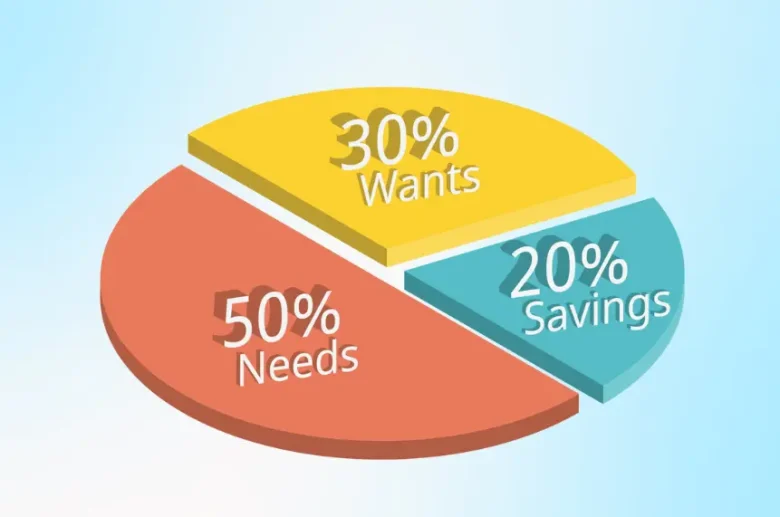Managing personal finances can be challenging if you don’t know where to begin. Millions of people use the simple 50/30/20 budgeting rule. This proven strategy divides your net income into three categories, making it easier to balance your lifestyle and financial goals. The 50/30/20 principle gives you flexibility while meeting your basic needs, enjoying life, and building wealth. Complex budgeting systems require you to track every penny. Whether you’re a recent graduate starting your first job or looking to simplify your financial planning, this budgeting method can help you manage your money without sacrificing your passion. You don’t need spreadsheets, apps, or financial knowledge to get started—its appeal lies in its simplicity.
Understanding the Components of the 50/30/20 Rule
The 50/30/20 rule divides your monthly net income into three categories. The first 50% goes to your basic needs: the expenses you can’t avoid. These expenses include rent or mortgage, utilities, groceries, insurance, minimum payments, and transportation. The non-negotiable bills keep you afloat. The challenge lies in distinguishing between true needs and true “wants.”
“Want” expenses—non-essential expenses that improve your quality of life—make up the next 30%. These include dining out, entertainment, hobbies, gym memberships, and non-essential purchases. “Want” expenses are pleasure-based expenses that reflect your lifestyle and preferences. This portion of your spending ensures you manage your money in a balanced way and avoid overspending.
Savings and debt repayment, in addition to the minimum payments, make up the remaining 20%. Create an emergency fund, contribute to your retirement account, save for major expenses, and make more payments on credit cards and loans. This portion of your spending determines your financial future and forms the foundation for your long-term prosperity and stability.
Benefits of the 50/30/20 Budget
Busy people love the 50/30/20 budget because of its many benefits. You can use it right away, without complicated calculations or tracking your expenses. Instead of categorizing your expenses into dozens of categories, you can divide them into three main categories. This approach reduces the psychological pressure of budgeting and increases the likelihood of long-term adherence.
The built-in flexibility allows you to change your lifestyle without going over budget. You can add a month’s worth of entertainment expenses to the 30% “Want” portion without affecting your basic needs or savings. This flexibility avoids the “all-or-nothing” mentality that many people adopt when they fall slightly short of their budget.
Most importantly, this rule automatically prioritizes current satisfaction and future financial security. By allocating 30% to “Want,” you avoid the feeling of constraint that often hinders budgeting. The 20% savings portion helps you spread your budget and prepare for unforeseen expenses and needs.
Apply the 50/30/20 Rule
Calculate your monthly after-tax income—your net income after taxes, insurance, and pension contributions. If your income fluctuates, use a recent average or lowest monthly income for consistency. Multiply this figure by 0.5, 0.3, and 0.2 to determine spending limits for categories.
Evaluate your existing expenses and categorize them as “Necessities,” “Needs,” and “Savings.” Be honest in your definition of “necessities” and “needs.” High-quality organic food might be a need, but groceries are a necessity. A basic cell phone plan is a necessity, but unlimited data and the latest smartphone are also essential. This activity often reveals hidden spending trends.
If your spending doesn’t meet the 50/30/20 rule, make adjustments gradually. Start with small changes, such as lowering your subscriptions or utility bills. For larger changes, consider whether you need to increase your income or adjust your lifestyle.
Tips for Successful Budgeting
The 50/30/20 rule requires consistency. Set up automatic transfers after each paycheck. This “pay yourself first” strategy prioritizes future financial goals over discretionary spending to prevent overspending. Treat savings as essential payments.
Please review your spending periodically to ensure you remain within your category limits. Weekly or biweekly checks can help you avoid overspending. Use a banking app, spreadsheet, or budgeting tool that works for you.
Maintain consistent spending percentages and adjust your spending categories flexibly. Some months you might spend more on car repairs or medical expenses. In these cases, you can temporarily cut back on “wanted” expenses while you save or adjust your “necessary” and “wanted” expenses to maintain your financial stability.
Long-Term Financial Success
The 50/30/20 principle is fundamental, not permanent, for managing your finances. Adjust your spending percentages as your income increases or your priorities change. High-income earners can save more than 20%, while those paying off high-interest debt can temporarily focus on debt reduction. This framework provides structure and allows you to adapt it to your financial situation and ambitions.
Progress is important, not perfect compliance. Sometimes you spend more than expected, and sometimes you save more. It’s crucial to carefully manage your expenses and make smart financial decisions. The 50/30/20 principle makes budgeting a balanced approach to achieving happiness and financial freedom. Take small steps, be patient with yourself during changes, and enjoy your financial stability and peace of mind.
FAQs
1. What if my needs are more than 50% of my income?
If your main expenses are more than 50% of your income, reduce your needs or increase your income. You might consider finding roommates to share housing costs, switching to a cheaper cell phone plan, taking a part-time job, or further developing your career.
2. What’s more important: paying off debt or saving?
Start by setting aside $500-1,000 in an emergency fund within 20% of your budget, then pay off your high-interest debt. After you pay off your high-interest debt, you can use the remaining 20% to save and pay off your low-interest debt.
3. Can I adjust the ratio based on my situation?
Of course you can. Please begin with the 50/30/20 rule and adjust it according to your needs. If you have no debt and want to retire early, you might choose the 50/20/30 rule.
4. How does this budget handle fluctuating income?
To ensure you can always pay your bills, it’s best to create a budget based on your lowest monthly income. Instead of spending more on what you consider “necessities,” focus on saving or paying off debt during the months when your income is higher.
5. Are they “necessities” or “wants”?
Basic living and work expenses include housing, utilities, groceries, insurance, and minimum mortgage payments. Dining out, entertainment, discretionary purchases, and upgraded services are considered “wants.” Consider whether you can comfortably live without these expenses for a few months.




